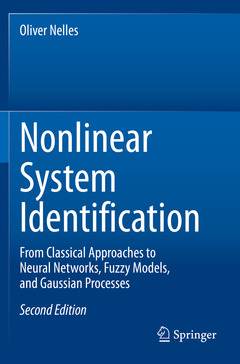Nonlinear System Identification (2nd Ed., 2nd ed. 2020) From Classical Approaches to Neural Networks, Fuzzy Models, and Gaussian Processes

This book provides engineers and scientists in academia and industry with a thorough understanding of the underlying principles of nonlinear system identification. It equips them to apply the models and methods discussed to real problems with confidence, while also making them aware of potential difficulties that may arise in practice.
Moreover, the book is self-contained, requiring only a basic grasp of matrix algebra, signals and systems, and statistics. Accordingly, it can also serve as an introduction to linear system identification, and provides a practical overview of the major optimization methods used in engineering. The focus is on gaining an intuitive understanding of the subject and the practical application of the techniques discussed. The book is not written in a theorem/proof style; instead, the mathematics is kept to a minimum, and the ideas covered are illustrated with numerous figures, examples, and real-world applications.
In the past, nonlinear system identification was a field characterized by a variety of ad-hoc approaches, each applicable only to a very limited class of systems. With the advent of neural networks, fuzzy models, Gaussian process models, and modern structure optimization techniques, a much broader class of systems can now be handled. Although one major aspect of nonlinear systems is that virtually every one is unique, tools have since been developed that allow each approach to be applied to a wide variety of systems.
Oliver Nelles was born in Frankfurt (Main), Germany, and got his Master’s and Ph.D. degree in Electrical Engineering and Automatic Control at the Technical University of Darmstadt. After being a Post-Doc at the Department of Mechanical Engineering at UC Berkeley he worked for Siemens VDO Automotive in Regensburg. During his five years in Regensburg he was project and group leader in the field of transmission control. Since 2004 he assumed a position as Professor for Automatic Control – Mechatronics at the University of Siegen. Oliver Nelles’ key research areas are: machine learning, system identification, nonlinear dynamic systems & control, design of experiments (DoE), fault diagnosis.
Date de parution : 10-2023
Ouvrage de 1225 p.
15.5x23.5 cm
Date de parution : 09-2022
Ouvrage de 1225 p.
15.5x23.5 cm
Thèmes de Nonlinear System Identification :
Mots-clés :
Fuzzy and neuro-fuzzy models; Linear optimization; Nonlinear local optimization; Linear and nonlinear dynamic system identification; Identification of dynamic systems; Local model networks HILOMOT; Nonlinear finite impulse response (NFIR); Long short-term memory (LSTM) networks; complexity
